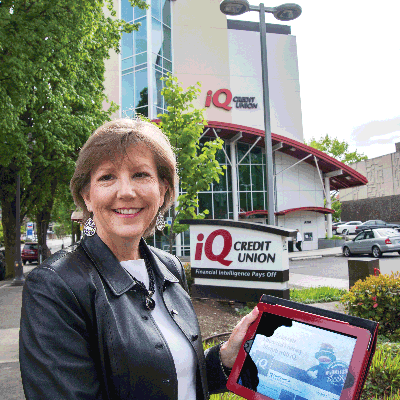While a banking video may not sound as exciting as a video of break dancing or ‘how to hook up your new stereo,’ LaChapelle said a recent fraud workshop video posted by iQ garnered a high number of views.
“It’s exciting to see those numbers, when we look at metrics such as number of clicks or views. That’s what people really like and want to hear about,” said LaChapelle. “You can’t get that sort of feedback from a printed newsletter.”
Managing a bank’s or credit union’s social media presence, however, can present challenges. At iQ, their online services department currently handles the postings. But LaChapelle said that as the credit union’s social media channel grows, “we’ll have to look at hiring more people.” She also said that as the rules of engagement on Facebook have evolved, social media posting requires more business decisions, effort and time to strategize.
At Wells Fargo, said Tom Unger, VP and Oregon region manager, they have an entire social media team, and have recently introduced social media training for the bank’s communications team (200 people across the nation).
At both Wells Fargo and iQ, only a few people are permitted to post or tweet. The risk, said Nelson and Unger, is that someone would claim they represented Wells Fargo, but really don’t, or don’t have accurate information.
“You need a social media group, but it requires a strong connection with the people who are interacting with customers every day,” said Nelson.
LaChapelle added that regulations exist for financial institutions’ use of social media, and during formal audits, auditors ensure these regulations are complied with, such as adequate protection of customer data.
Of course, one of the benefits of social media is that it is two-way communication. Wells Fargo has created two social media “listening posts” that monitor what’s being said about the company in social media. Recently, said Unger, they heard about a Forbes blogger in Forest Grove, Oregon, who posted about the great service she received from a Wells Fargo teller. Based on that post, Wells Fargo wrote a story about the teller, and has “used that story in a lot of separate places, both online and in-person, even in his local newspaper.”
LaChapelle shared two tips for success for any business that plans to use social media to connect with their customers. Number one, she said, is to “Stay active – don’t just put it up there to say you did it.” And number two, “Remember the word ‘social’ – it’s not ‘advertising media’, it’s ‘social media’.”
Another thing to remember, added Unger, is that while “social media is important, we also believe that good old face-to-face communication is irreplaceable. Social media augments what we do, but doesn’t replace what we do.”
At iQ, too, said LaChapelle, social media is just one of many communication channels, calling it “another opportunity to connect.”
But just because iQ or Wells Fargo have a good handle on Facebook or Twitter doesn’t mean that’s the end of the story for financial institutions and social media.
“Social media is the new frontier,” said Unger. ““We discover something every day as a society about social media – what’s going to be the new program that no one has heard about yet?”
LaChapelle said that iQ watches social media trends, focusing on security and who will benefit from new programs. Some things, like text banking and MySpace, have died early quiet deaths in the banking industry. Others, like Facebook, YouTube and Twitter, are wildly popular with bank and credit union customers.
And, while there may be some risk associated with trying new social media programs, there is also risk in being too risk-averse.
“You can’t stand on the sidelines too long, or you will miss it,” stated LaChapelle.
{jathumbnail off}




